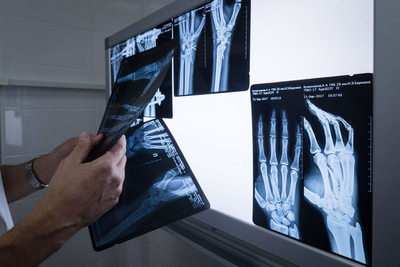
X-ray examinations are among the most common in modern medicine. X-rays are used to obtain simple X-rays of bones and internal organs, fluorography, computed tomography, and angiography. The Day of the Radiologist is celebrated in November every year. Why? But because on the deep evening of November 8, 1895, in the laboratory of the University of Würzburg, the German physicist Wilhelm Konrad Roentgen, already about to leave the laboratory and having turned off the light, noticed a luminous spot in the darkness. It turned out that a screen made of barium synergistic was glowing. Why is it glowing? The sun had gone down a long time ago, the electric light could not cause a glow, the cathode tube was turned off (?), and, in addition, it was covered with a black cardboard case. Roentgen looked again at the cathode tube: it turns out he forgot to turn it off! Fumbling for the switch, the scientist turned off the receiver – the same glow from the screen disappeared. I switched on the receiver – the glow reappeared. So the glow is caused by the cathode tube! But how? The cathode rays are held back by the sheath, and the metering gap between the tube and the screen cannot be overcome by the rays! Recovering from amazement, Roentgen returned to the laboratory and began to study the discovered phenomenon. He called the new, which were not guided rays, X-rays. Roentgen found that X-rays had the properties of light, but they were ten thousand times shorter than light ones, so they penetrated well through various media. Rome of this scientist’s hand, caught between the cathode and the screen, received an image: bones were visible on the screen! After working all night, the scientist returned home exhausted to rest a little, and the next day to start work on the study again. X-rays.
After 6 weeks, Roentgen introduced the world to his brilliant discovery. The scientific community quickly appreciated the excellent properties of the rays discovered by X-rays, and after 20 days, on January 23, 1896, at a meeting of the Society of Naturalists in Würzburg, they were used to examine a finger damaged by a bullet. At this meeting, anatomist and histologist Albert Keller proposed to name X-rays after their author – X-rays. VC. Roentgen refused the patent for the invention of X-rays, declaring that his discovery belonged to all of humanity. This made it possible for engineers from different countries to design X-ray machines and use them for medical needs. In 1901 V.K. Roentgen became the first Nobel laureate in physics. The scientist donated this prize to the fund of the University of Würzburg. Thus, X-ray discovered at the end of the 19th century, gave impetus to the achievements of radiation diagnostics in the 20th century, without which modern life is inconceivable. Currently, in the medical practice of almost all countries, the name of X-rays discovered by X-rays is retained, and only Russian medicine still calls X-rays X-rays, and the method of obtaining a visual picture using these rays is X-ray. This expresses the deep respect and love that Russian medical science and practice have for the founder of radiation diagnostics.
The new infection COVID19 once again showed all of mankind what role the discovery of X-rays by Wilhelm Konrad Roentgen on November 8, 1895 plays in its salvation. Without reliable diagnostics of lung pathology, characteristic of the “PLAGUE of the XXI century” by means of X-ray examination, it would be impossible to save people suffering from this fatal ailment. However, X-rays, unfortunately, cannot improve the human brain or destroy the stupidity and ignorance of modern savages who do not want to be vaccinated against COVID19 and wear protective equipment against airborne infections. Alas!
Stay healthy! Take care of yourself, your loved ones and all people, not even loved ones. There will be no other life!
Congratulations to colleagues and patients on the Day of the Radiologist!
Head of the Department of Radiation Diagnostics and Therapy, Doctor of Medical Sciences, Professor
Vorotyntseva Natalia Sergeevna
A resident of the Department of Radiation Diagnostics and Therapy Isaenko Roman Valerievich
